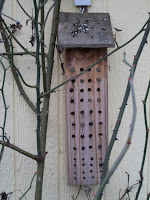One of the decisions I made with Ed when we set up the bees in the Eagle's Rest Garden was that we'd let most of the swarms go feral. After all, his garden sits in the middle of a wooden area, there are forest tracts over the fences in every direction. Lots of hollow trees and natural structure for colonies to inhabit. Here in the middle of the third year of those original hives, I think I've only captured one swarm from them; the rest have taken flight on their own terms. The idea is to repopulate and build up locally adapted honeybees in the surrounding woods who will then be there to pollinate. It's part of that 'save the bees' idea that got me started in the first place.
Now I know there is a lot of discussion pro and con about this, and frankly ... we don't care. You're either on the bus with restoring feral bee colonies, or you are not. A link to the feral bee projects is
here, and I don't have a link to those who oppose it. [smile] There's currently a bit of a discussion about the idea on the
Warré group, too. You can easily find all the talking points of the issues if you look on the net.
Anyway ... I harvested about 5 swarms in the last couple of weeks, including three that originated from my own hives here behind the house. One other swarm that issued forth was from my Biodynamic Lang, full of those pretty golden bees. Here's the swarm as it first began to settle in a tree just over the fence from the hive:
Well ... aside from the boat, there's a big dog over there, just outside of camera range ... and the fence is tall ... and at the time I didn't have an empty hive ready to put them in ... and there was this little voice coming from somewhere close to being perched on my shoulder, "Hey, let 'em go." I was all set to pass up this swarm and let them become feral repopulator/pollinators. Yet it got harder when they eventually settled into this clump, about four feet off the ground, just beyond the fence:
Now
who could resist such a nice cluster??? Imean, all ya gotta do is slip the bucket up under them, bang on the branch (
or even just snip it off!) and .. wall - ah ... you got a swarm o' pretty golden bees. The dog isn't mean, Molly and I feed him cookies all the time. The fence opens pretty easily. The bees could live in the bucket until I got another hive ready. What if they decided to settle in that guy's boat? Now the little voice was saying "GET THEM!!!" I decided that if they were there in the morning, I would. But that evening I began to question my 'save the bees' principles. Imean, if you've decided to increase the ferals in the local neighborhood, these are prime candidates. I should. I
should let them go if I'm gonna be true to my values. [sigh]
Okay, they
were there the next morning, even though the temp had drifted down to 34F just before dawn. But so was a swarm in a horse park over by the filbert groves. I went and collected those bees first, since the horse owners were panicked. Late that afternoon, the golden swarm was still on that branch. By now the little voice was ambivalent. Sometimes it was "Go", sometimes it was, "Get them." Procrastination is our friend.
By the next morning, they were -- indeed -- gone. I'm sure they found a nice oak somewhere between my fence and
Parvin Butte , less than 1000 yards away.
And hey .. I learned a lot just watching them for 48 hours.

 A close look reveals at least a half dozen full Orchard Mason Bee cocoons in the cylindrical holes I drilled. (There is a smaller set of holes below them for another variety of mason bee that I dunno the exact name of. The Leaf Cutter bees use 'em too. There are some full cocoons of theirs in this bee block as well.)
A close look reveals at least a half dozen full Orchard Mason Bee cocoons in the cylindrical holes I drilled. (There is a smaller set of holes below them for another variety of mason bee that I dunno the exact name of. The Leaf Cutter bees use 'em too. There are some full cocoons of theirs in this bee block as well.)